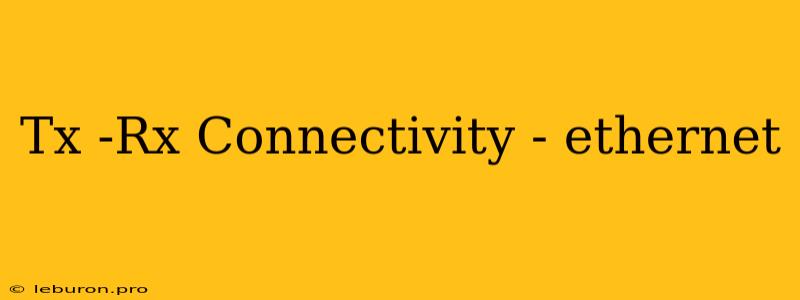In the realm of modern networking, seamless Tx-Rx connectivity is paramount for ensuring reliable and efficient data transmission. This intricate dance between transmitter (Tx) and receiver (Rx) units hinges on a robust and adaptable infrastructure, with Ethernet emerging as a ubiquitous and versatile backbone. This article delves into the intricacies of Tx-Rx connectivity in Ethernet networks, exploring the fundamental principles, key components, and critical considerations for optimal performance.
Understanding Tx-Rx Connectivity in Ethernet
At its core, Tx-Rx connectivity refers to the physical and logical connection between the transmitter and receiver components within an Ethernet network. This connection facilitates the bidirectional flow of data, enabling devices to communicate effectively. In essence, the transmitter encodes data into electrical or optical signals, which are then transmitted across the network medium. The receiver on the receiving end decodes these signals and delivers the data to the intended destination.
Key Components of Tx-Rx Connectivity
Several crucial components contribute to the establishment and maintenance of robust Tx-Rx connectivity in Ethernet networks:
1. Ethernet Cables
Ethernet cables serve as the physical medium for data transmission, connecting devices to the network. These cables come in various types, including twisted-pair (UTP), shielded twisted-pair (STP), coaxial cable, and fiber optic cable. The choice of cable type depends on factors like transmission distance, data rate, and environmental considerations.
2. Ethernet Connectors
At the ends of Ethernet cables, connectors facilitate the physical connection to network devices. Common connectors include RJ-45, RJ-11, and SFP modules. These connectors ensure reliable electrical contact and signal integrity, guaranteeing smooth data transmission.
3. Network Interface Cards (NICs)
Network Interface Cards (NICs) reside within devices and provide the physical interface for connecting to the network. They house the transmitter and receiver components, responsible for encoding, transmitting, decoding, and receiving data over the Ethernet medium.
4. Switches and Routers
Switches and routers act as central hubs within the network, connecting multiple devices and facilitating data routing. They play a crucial role in ensuring efficient Tx-Rx connectivity by managing data flow, reducing network collisions, and providing address translation.
Ensuring Optimal Tx-Rx Connectivity
To ensure optimal performance and reliable Tx-Rx connectivity in Ethernet networks, consider the following factors:
1. Cable Quality and Length
The quality and length of Ethernet cables significantly impact data transmission integrity. Using high-quality cables, certified for the required data rate and transmission distance, is crucial for maintaining signal strength and minimizing interference. Exceeding the maximum cable length limits can lead to signal degradation and data loss.
2. Connector Compatibility
Ensuring compatibility between connectors is essential for establishing physical connections. Utilizing the correct connector types and ensuring proper mating can prevent signal loss and ensure reliable data transmission.
3. Bandwidth and Throughput
The bandwidth of the network infrastructure and the throughput of individual devices impact the overall Tx-Rx connectivity performance. Adequate bandwidth is essential to handle high data volumes and ensure smooth transmission.
4. Network Configuration
Proper network configuration, including IP addressing, subnet masks, and routing protocols, is vital for establishing seamless Tx-Rx connectivity. Misconfigured settings can lead to network errors, data loss, and communication breakdowns.
5. Network Security
Implementing robust security measures, such as firewalls, intrusion detection systems, and access control lists, is essential to protect the network from unauthorized access and data breaches.
Conclusion
Tx-Rx connectivity plays a vital role in the seamless operation of modern Ethernet networks. By understanding the fundamental principles, key components, and crucial considerations for optimizing performance, network administrators can ensure reliable data transmission, efficient communication, and a robust digital infrastructure. As technology continues to evolve, the demand for faster, more reliable Tx-Rx connectivity will only increase, highlighting the importance of continually evaluating and adapting network infrastructure to meet these growing demands.
